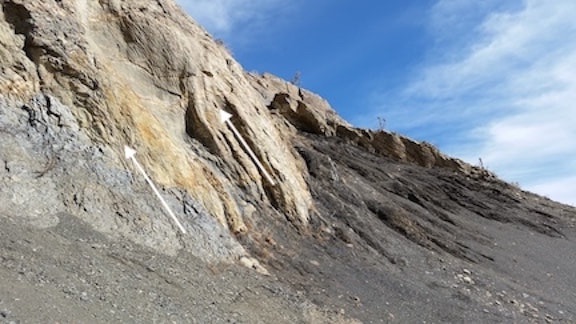European naturalists of the 18th Century were well grounded in classical languages and the myths of the Greeks and Romans. It is understandable that they might assign lava and ash to the god of fire, Vulcan, who had his forge in the smoky mountain Vulcano in the Mediterranean.
But what lies beneath those boiling craters?
There are places where deep erosion has stripped away former volcanic landforms, giving us a look at the interior of the once pulsing forge. What we discover here are bodies of rock that have cut across or squeezed between older layers of stratified rock, shouldering them aside before being frozen in place.
But what lies beneath those boiling craters?
There are places where deep erosion has stripped away former volcanic landforms, giving us a look at the interior of the once pulsing forge. What we discover here are bodies of rock that have cut across or squeezed between older layers of stratified rock, shouldering them aside before being frozen in place.
This is the behavior of something fluid or paste-like being injected upward and outward from below. Geologists adopted the Greek word magma, "thick ointment", to describe molten rock able to move in the Earth's interior. We now understand that magma is a complex, mobile mix of liquified silicate glass, peppered with suspended crystals, and charged with dissolved gas, mostly superheated water.
This crystallized magma never made it to the Earth's surface. The environment it records is subterranean, sub-volcanic. The texture of these rocks indicates that they cooled under large confining pressures. There are no bubbles or glassy froth. The rocks are compact and contain easily visible crystals.
The fact that these crystallized magmas cut across, or intrude, preexisting rock lets us know the relative order in which the rocks formed. An intrusion of magma is always younger than the rocks it penetrates. For that matter, a fault is always younger than the rocks it offsets. A buried surface of erosion is always younger than the rocks it cuts. This common sense observation has been summarized as the Principle of Cross-cutting Relationships.
This principle is a useful complement to the Principle of Superposition. Both principles help geologists interpret rocks as records of events which can be ordered in terms of before and after.
This crystallized magma never made it to the Earth's surface. The environment it records is subterranean, sub-volcanic. The texture of these rocks indicates that they cooled under large confining pressures. There are no bubbles or glassy froth. The rocks are compact and contain easily visible crystals.
The fact that these crystallized magmas cut across, or intrude, preexisting rock lets us know the relative order in which the rocks formed. An intrusion of magma is always younger than the rocks it penetrates. For that matter, a fault is always younger than the rocks it offsets. A buried surface of erosion is always younger than the rocks it cuts. This common sense observation has been summarized as the Principle of Cross-cutting Relationships.
This principle is a useful complement to the Principle of Superposition. Both principles help geologists interpret rocks as records of events which can be ordered in terms of before and after.


 RSS Feed
RSS Feed
